By PHILIP HOPKINS
CARBON capture and storage in Gippsland has received a boost with a milestone event – the celebration of the injection of 100,000 tonnes of carbon dioxide underground by the CO2CRC at the Otway International Test Centre.
The chief executive of the CO2CRC, Dr Matthias Raab, said the event was a globally significant in demonstrating the feasibility, safety and scalability of geological carbon storage.
“This achievement cements OITC’s reputation as one of the world’s leading subsurface laboratories and reinforces Australia’s position as a trailblazer in applied climate science,” he told the Express.
“The importance of the milestone of 100,000t of CO2 is not the quantity, but as a symbolic milestone.”
The OITC, in the west of the state, consists of seven purpose-drilled CO2 storage wells more than 1.5 kilometres deep within a roughly one kilometre square area.
Attendees at the celebration included Victoria’s Lead Scientist, Dr Amanda Scales; a local federal Liberal MP and former Coalition minister, Dan Tehan; and representatives from CarbonNet, which aims to build a pipeline from the Latrobe Valley taking CO2 emissions from industry for storage in empty Bass Strait reservoirs.
The Minister for Energy, Resources and Climate Action, Lily D’Ambrosio, was invited, but a spokesman said she could not attend due to other commitments but passed on her congratulations for hitting the milestone.
Dr Raab said the CO2CRC had gone from ‘blue sky’ research to commercially relevant demonstrations across the whole value chain of CCS.
“We are developing the next generation technology for the next generation projects. We are developing monitoring technology to safeguard the environment, to be complaint with regulations, to reduce the cost of operating CCS or geological carbon storage projects – technology that we can rely upon for high integrity, the measurement of the permanent storage of CO2 and permanent abatement, for hundreds and thousands of years,” he said
Dr Raab said the CO2 was being ‘packed away’, so “the climate benefits are immediate and permanent”.
“This is easy to demonstrate; we have been demonstrating this together with national and international research partners, eight Australian universities, GeoScience Australia, CSIRO, and regional universities, including Federation University, with whom we have been working for many years,” he said.
The federal Resources Minister, Madeleine King, announcing new CCS exploration permits earlier this year, emphasised the need for CCS. The Minister acknowledged that the International Energy Agency, the CSIRO, the UN Intergovernmental Panel on Climate Change and Australia’s Climate Change Authority “all identify that carbon capture utilisation and storage will be needed to support the net zero transition”.
Without offshore CCS, storage hubs and shared infrastructure, hard-to-abate industries such as concrete and steel had no chance to reduce their emissions under the Safeguard Mechanism, Dr Raab said.
The CO2CRC is in a paradoxical position. “We have been in leadership globally for 21 years. We are recognised across the entire world – but are barely known and recognised in Victoria,” he said.
“We receive an incredible amount of attention from researchers globally, from Asian partners in Japan and Korea, with whom we have long-term, trusted relationships. We recently signed a memorandum of understanding with Carbon Management Canada. We are the only two organisations that make national research infrastructure available for scientists. Our work and data are published without encumbrances and peer-reviewed by experts from around the globe.”
Dr Raab said the significance for Victoria was that “Victoria has an organisation genuinely leading the world to develop the technologies required to expedite the energy transition”.
“The credibility of the work that we undertake is rigorously reviewed and tested over decades, so we know how long it takes to develop new technologies,” he said.
“The reason I say it, we see ‘start-ups’ with great publicity popping up everywhere; they are getting awards from newspapers without due diligence, they are getting listed on the top 100 list of Australian green CEOS without providing any evidence about the credibility of their work – some, not all of them.”
Dr Raab said the lessons from OITC pave the way for replicable solutions globally.
“While this milestone is significant, it is not the end of the journey. Continued funding and support are essential to advance our understanding of underground storage for CO2 and emerging solutions like hydrogen,” he said.
“Future research will further de-risk storage technologies, optimise monitoring systems and improve cost-effectiveness, making CCS a cornerstone of the energy transition.”











